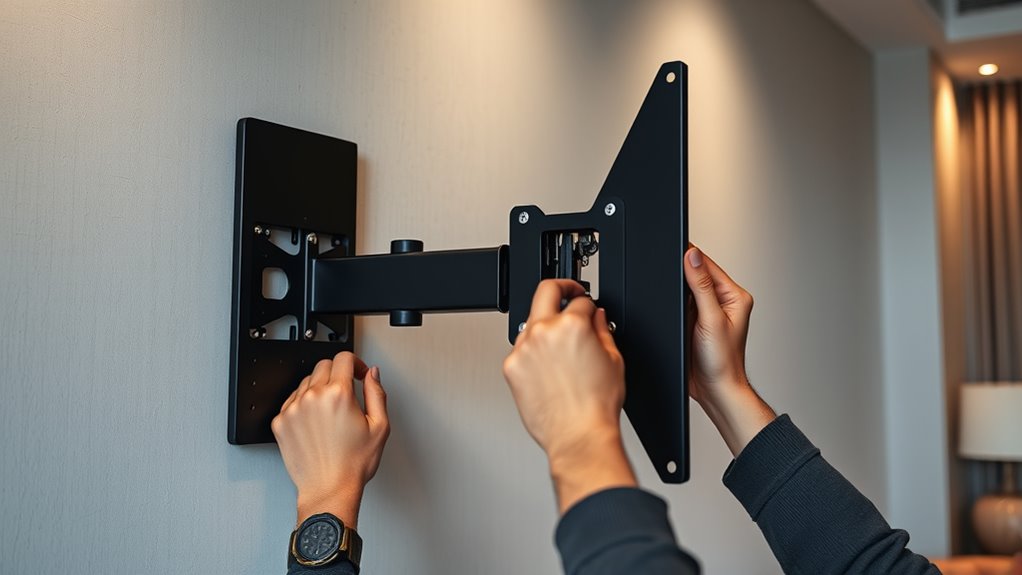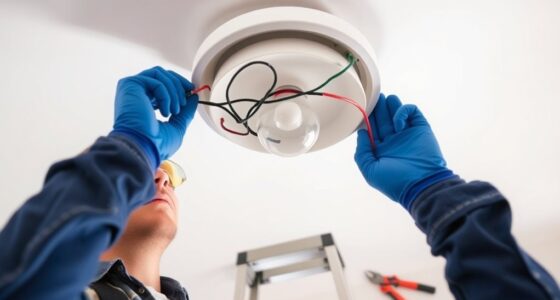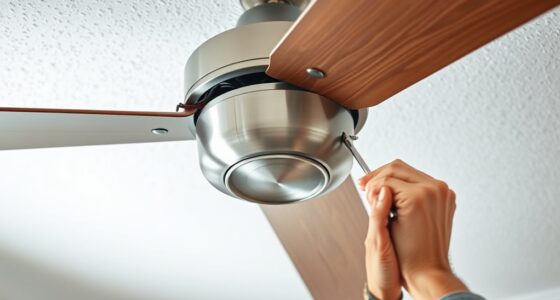To select the right wall mount for your TV, consider the size, weight, and VESA pattern to guarantee compatibility. Decide between fixed, tilting, or full-motion mounts based on your space and viewing needs. Use a stud finder and proper hardware for secure installation on drywall, concrete, or plaster walls. Keep cable management in mind for a tidy look. If you continue exploring, you’ll discover detailed steps for installing your mount safely and effectively.
Key Takeaways
- Determine your TV size, weight, and VESA pattern to select a compatible wall mount with adequate capacity.
- Choose the appropriate mount type (fixed, tilting, full-motion, corner) based on your viewing needs and space.
- Use a stud finder and proper anchors to securely attach the mount to wall studs or suitable surfaces.
- Gather necessary tools such as drills, level, screws, and cable management accessories for a safe and organized installation.
- Regularly inspect and maintain the mount to ensure stability, and position your TV at a comfortable viewing height.

Installing a wall mount for your TV is a great way to save space and create a sleek, modern look in your home. The first step is understanding the different types of mounts available. Fixed mounts keep your TV flush against the wall, offering a minimalist appearance but no adjustability. Tilting mounts let you angle the screen up or down, which can be helpful if you need to improve viewing angles from different seats. Full-motion mounts are more versatile, allowing you to tilt, swivel, and extend the TV for the best possible viewing experience, especially in rooms with multiple seating areas. Corner mounts are designed specifically for mounting in corners, helping you utilize space efficiently, while low-profile mounts are another term for fixed mounts, perfect if you prefer a clean, unobtrusive setup.
Installing a wall mount saves space and offers sleek, modern TV setup options with fixed, tilting, full-motion, corner, and low-profile mounts.
When choosing a mount, consider key features like weight capacity to guarantee it can support your TV’s weight. Compatibility with your TV’s VESA pattern is vital—measure your TV’s VESA pattern and compare it with the mount’s specifications. Cable management is another important feature: mounts with built-in cable clips or channels help keep cords organized and out of sight. Durability matters too; opt for mounts made from sturdy materials to guarantee long-term stability. Think about whether you’ll benefit from adjustability features like tilt or full-motion, especially if you plan to change angles frequently. Additionally, understanding the contrast ratio of your setup can help optimize your viewing experience by ensuring your display can handle dark scenes effectively.
Before installation, measure and prepare your wall carefully. Use a stud finder to locate wall studs, as these provide the necessary support for your TV. Confirm the TV’s size and VESA pattern to select an appropriately sized mount. Check what type of wall you have—drywall, plaster, or concrete—and choose suitable anchors and hardware accordingly. Make sure the area around the mounting spot is clear of obstructions, and double-check your measurements to guarantee proper placement.
Gather your tools and materials, including a drill with bits, screws, anchors, a level, mounting brackets, and cable ties. Using the right tools and hardware helps prevent damage and ensures a secure installation. Keep in mind your budget; fixed mounts tend to be more affordable, while full-motion mounts cost more because of their added flexibility. Corner mounts and mounts with extra features like cable management might also influence your budget.
During installation, be aware of common challenges: mounting on concrete or plaster walls can be tricky, and managing cables neatly can require extra effort. Ensuring the mount is securely attached to wall studs and that your TV is level can be challenging but is essential for safety and aesthetic appeal. After mounting, test the stability, adjust viewing angles, and secure cables with ties for a tidy look. Regularly inspect the mount to catch any signs of wear, and position your TV at an ideal height for comfortable viewing. Proper planning and careful installation make your wall-mounted TV both safe and stylish.
Frequently Asked Questions
Can I Mount a TV Without Professional Help?
You can mount your TV without professional help if you’re comfortable with tools and follow the instructions carefully. Make sure to pick the right mount for your TV, locate wall studs, and use the proper anchors. Use a level to keep everything straight, and lift the TV safely. If you’re unsure about any step or the weight, consider asking someone for assistance or hiring a professional to avoid accidents.
What Is the Maximum Weight Capacity for Wall Mounts?
Ever wonder how much weight your wall mount can support? Most fixed mounts support up to 180 lbs, perfect for average TVs, while full motion mounts usually support around 125 lbs. Heavy-duty mounts for larger screens can hold 275 lbs or more. To keep your TV safe, always check the mount’s specifications, guarantee proper installation, and follow safety standards. Don’t forget, the right mount matches your TV’s size and weight for secure support.
Are There Specific Mounts for Curved TVS?
Yes, there are specific mounts designed for curved TVs. These mounts accommodate the unique shape and contours of curved screens, ensuring a secure fit and stability. They often feature adjustable tilt and swivel options to optimize viewing angles. Make sure the mount supports your TV’s VESA pattern and weight capacity. Properly installed, these mounts keep your curved TV close to the wall, enhancing both safety and aesthetics.
How Do I Hide Cables Effectively?
To hide cables effectively, you can use in-wall cable management kits or PowerBridge solutions that let you run cables inside the wall. Surface-mounted cable covers or channels also work for a quick, tidy look. Make sure your cables are long enough to reach devices without strain, and secure them with velcro straps. Always prioritize safety by choosing UL-certified products and verifying compatibility with your wall type and TV size.
Will Mounting a TV Damage My Wall?
Mounting a TV can cause damage if you don’t do it properly. If you don’t secure the mount into wall studs or use strong anchors, it might lead to holes, cracks, or dents. Over-tightening screws can also weaken the wall. To prevent damage, locate studs, use the right anchors, and avoid over-tightening. Proper installation guarantees your wall stays intact and your TV stays secure.
Conclusion
With the right wall mount, you’re turning your TV into the centerpiece of your room, like a work of art on display. Just remember to choose the perfect size, check your wall’s strength, and follow the installation steps carefully. Once it’s up, you’ll enjoy a sleek, clutter-free setup that makes your space feel bigger and more inviting. So go ahead—mount that TV and enjoy your new view, brighter and clearer than ever!










